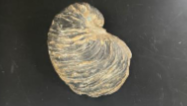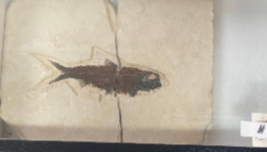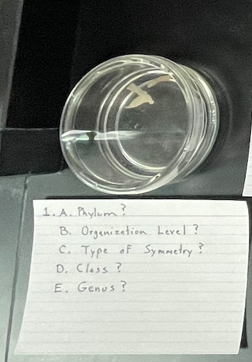bio104 lab midterm
1/128
There's no tags or description
Looks like no tags are added yet.
Name | Mastery | Learn | Test | Matching | Spaced |
|---|
No study sessions yet.
129 Terms

is this a true form fossil or mold form?
true form

is this a true form fossil or a mold form?
mold form
what is evolution
a process of change overtime that results in speciation
Define natural selection
the process of organisms changing to adapt to environmental conditions that carries on through generations
Define fossil
Preserved remains of once living organisms
Define nucleic acid sequencing
Looking at organisms relations from molecular, genotypic characteristics
Define phylogenetic tree
how species will grow and branch off of each other
What are the three advantages of evolution?
Allow life to occupy different niches, occupy new environments, and adapt to changes
Explain divergent evolution
when a common ancestor results in different species overtime
Explain convergent evolution
when overtime different species evolve into similar species due to environmental factors
Ray and lobe finned fish and sharks evolved from which extinct group of fish?
placoderms – plated fish
Lampreys and hagfish are most closely related to which group of fish?
ostracoderms
How many extant groups of fish are on earth today?
5
Do the Acanthoidii have descendants on earth today?
Yes – Sarcopterygii, Chondrichthyes, and Actinopterygii
name and describe the three cell types of a sponge
epidermal cell - outerepithelum wall, water comes in ostia and exits osculum
amoebocytes - mesohy, transports nutrients, evolved in sexual reproduction, and secretes spicules
choanocytes - digest food from passing waste, the flagelblled contributes to the water circulation
what does it mean to be asymmetrical
lack define symmetry and grow irregularly
the structures that form an internal framework and are secreted by the amoebocytes in the sponges are called
spicules
what does diploblastic radiatans mean
organisms with radial symmetry and two germ layers
what is an example of a diploblastic radiatan
cnidarians
the viscous noncellular matrix that allows for diffusion of material throughout the body of the cnidarians is the
mesoglea
describe the structure and function of the medusa stage
sexual reproduction, gametes(sperm and egg) are produced, fertilization occurs in the water, zygote forms and enters embryogenesis to reach the early gastrula stage
what happens in the early gastrula stage
the embryo forms into planula in the water where it is free-floating, and once it settles if not covered by sediment it metamorphosis’ into polyp stage
specialized cells used by cnidarians to capture prey are called
cnidocytes
tapeworms and many flukes are hermaphroditic, what does that mean
having both male and female reproductive organs
what type of symmetry do flatworms exhibit
bilateral
what level of organization is present in flatworms
organ level
what embryonic tissues are present in flatworms
ectoderm, mesoderm, and endoderm
what structure is used for locomotion in gastropods
their foot
how do snails feed
the radula- a rasping tongue like structure
describe the mollusks complete digestive tract
they have an opening, the mouth, for food to enter and they have an exit, the anus, for waste to leave
what is the foot of the cephalopods modified into and for what function
siphon used for water propulsion
what dp clams and other bivalve mollusk use to bury themselves
their foot
what is the class of marine worms
polychaeta
what is the class of earthworms and leeches
clitellata
what are the membranes that divide segments
septa
what grinds the food into small pieces
gizzard
what removes metabolic waste
hermapphrodites
the primitive brain is known as the
cerebral ganglia
what is the method of respiration in earthworms
their skin
in the parasitic nematoades the adult worm develops within the host, what two stages in their life cycle are they infectious as
adult and larvae
trichinella spiralis is known as the pork/bear roundworm and causes a debilitating muscle disease in humans. what is the disease called and what can be done to prevent it
trichinosis and fully cooking meat
list the common name of ascaris lumbricoides and the site of infection
giant intestinal roundworm - lungs
list the common name of enterobious vermicularis and the site of infection
pinworm infection - anal area
list the common name of tichinella spiralis and the site of infection
pork/bear worm - muscle disease
list the common name of necator americanus and site of infection
human hookworm - intestine
what are aranae
spiders
what are choleoptera
beetles
what are merostomata
horseshoe crab
what are diptera
flies
what are decapoda
shrimp
what are acari
mites and ticks
what are cirrepedia
barnacles
what are centipoda
centipedes
what are lepidoperta
butterfly
what are milipoda
milipedes
what arthropod are the most numerous and what made them so well adapted
choleptra or beetles - their rectum
what is the difference between centipedes and milipedes
centipedes have one pair of appendages per segment while millipedes have two
in decapods like crayfish they have bivamous appendages, what are they made of
gills and walking legs
what structure are found in a crayfishes anterior stomach and is used for grinding up food
three teeth named grindstones
what is an example of an asteroidea
sea stars
what is an example of a crinoidea
sea lilies
what is an example of an echinoidea
sea urchin or sea dollars
what is an example of a ophiuroidea
brittle stars
what is an example of a holothuroidea
sea cucumber
what does cutaneous respiration refer to
exchange of gases through the skin
what type of symmetry is exhibited in larval enchinoderm
bilateral
what type of symmetry is exhibited in adult echinoderms
pentaradial
what type of skeleton do the echinoderms have
endoskeleton
what is an example of an anura
frogs and toads
what is an example of a caudata
salamanders and newts
what is an example of a chelonia
turtle and tortosie
what is an example of a squamata
snakes and lizards
what is an example of a crocdylia
crocodiles and alligators
what is the function of the cloaca
it is the terminal end of the digestive, urinary, and reproductive tracts
how do amphibians and reptiles regulate their body temperature
basking in the sunlight
what organ filters blood from the digestive tract and detoxifies chemicals
liver
what organs filter nitrogenous waste allowing it to be eliminated with urine
kidneys
what organ stores blood cells
spleen
what is the fate of the blastopore in chordates
they are deuterostomes and the anus develops first
what type of symmetry is exhibited in chordates
bilateral
what is the method of feeding in the adult lanceletes and tunicates
filter feeding
what chordate characteristic is not found in any adult chordates
notochord
what is an example of a myxini
hagfish
what is an example of a cephalospidomorphi
lampreys
what is an example of a chondricthyes
skates, sharks, and rays
what is an example of a sarcopterygii
lobed-finned fishes
what is an example of a actinopterygii
ray-finned fishes
in what ways are boney fish better adapted to swimming than the cartilaginous fish
bony skeleton swim bladder and the operculum
how is a vertebral column an improvement over a notochord
protection
what evidence of segmentation is found in the bony fish
vertebral column
what is the function of the operculum found in bony fish
covers and protects gills and permits water pumping over the gills
what is the function of the swim bladder in the bony fish
regulates their buoyancy density
how many chambers does a fish hear have, what are they called, and what are their functions
two chambers, atrium which is the recieving chamber, and the ventricle which is the pumping chamber
what are the SIX anatomical features that have aided birds in the evolution of flight
efficient respiration, efficient circulation, endothermy, feathers, flight skeleton, and a four chambered heart
what order of birds includes about 60% of them and what characteristics do they share
passeriforms - a tendon in their foot allowing for perching
what is the method of reproduction in montremes
laying shelled eggs
what is the method of reproduction in marsupials
give birth to undeveloped young and continue to grow them in a pouch
what is the method of reproduction in placental mammals
give birth to developed young
birds and mammals have a four chambered heart, how is this an improvement over a three chambered heart?
allows for a high supply of oxygenated blood to all parts of the body

A : porifera
B : cell level organization
C : asymmetrical
D : caleareae
E : grantia